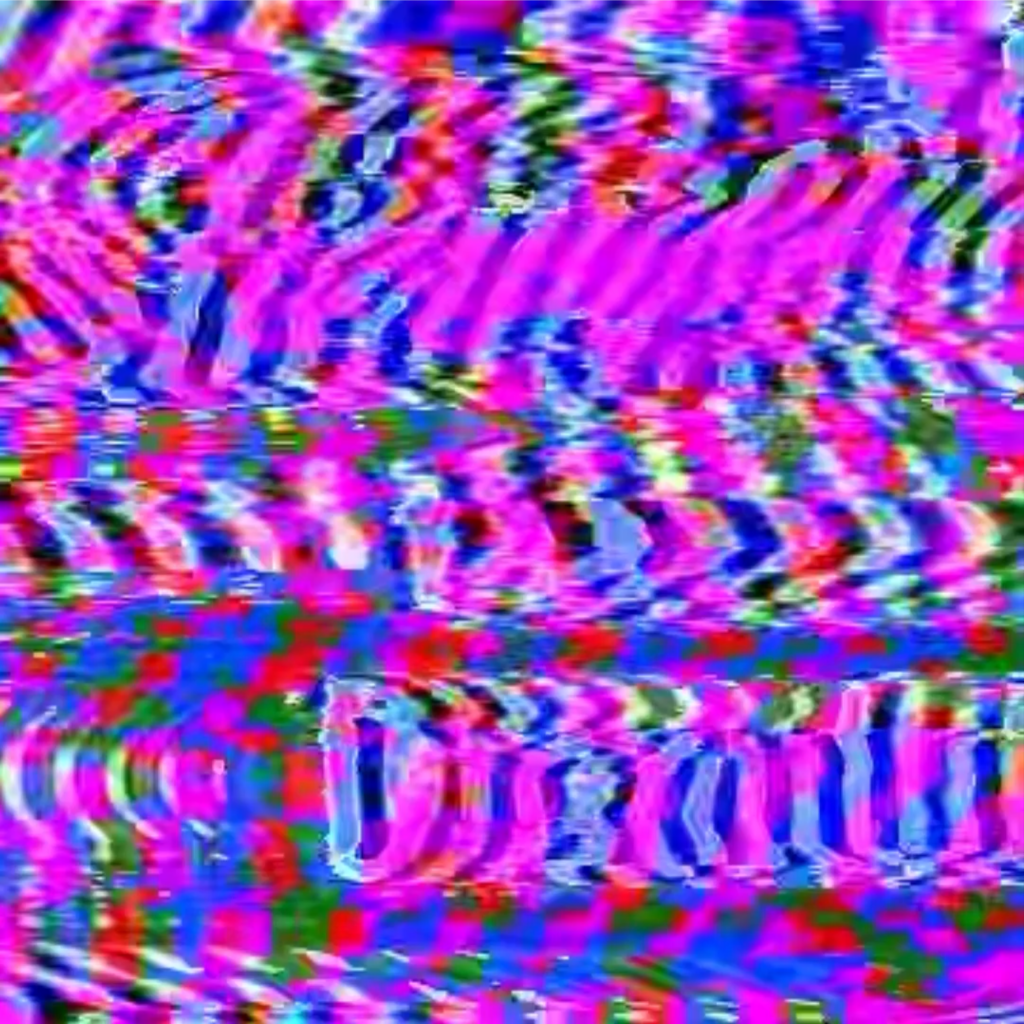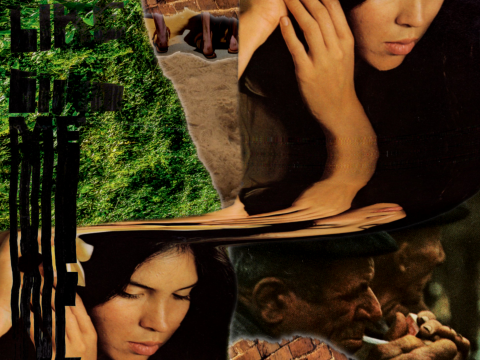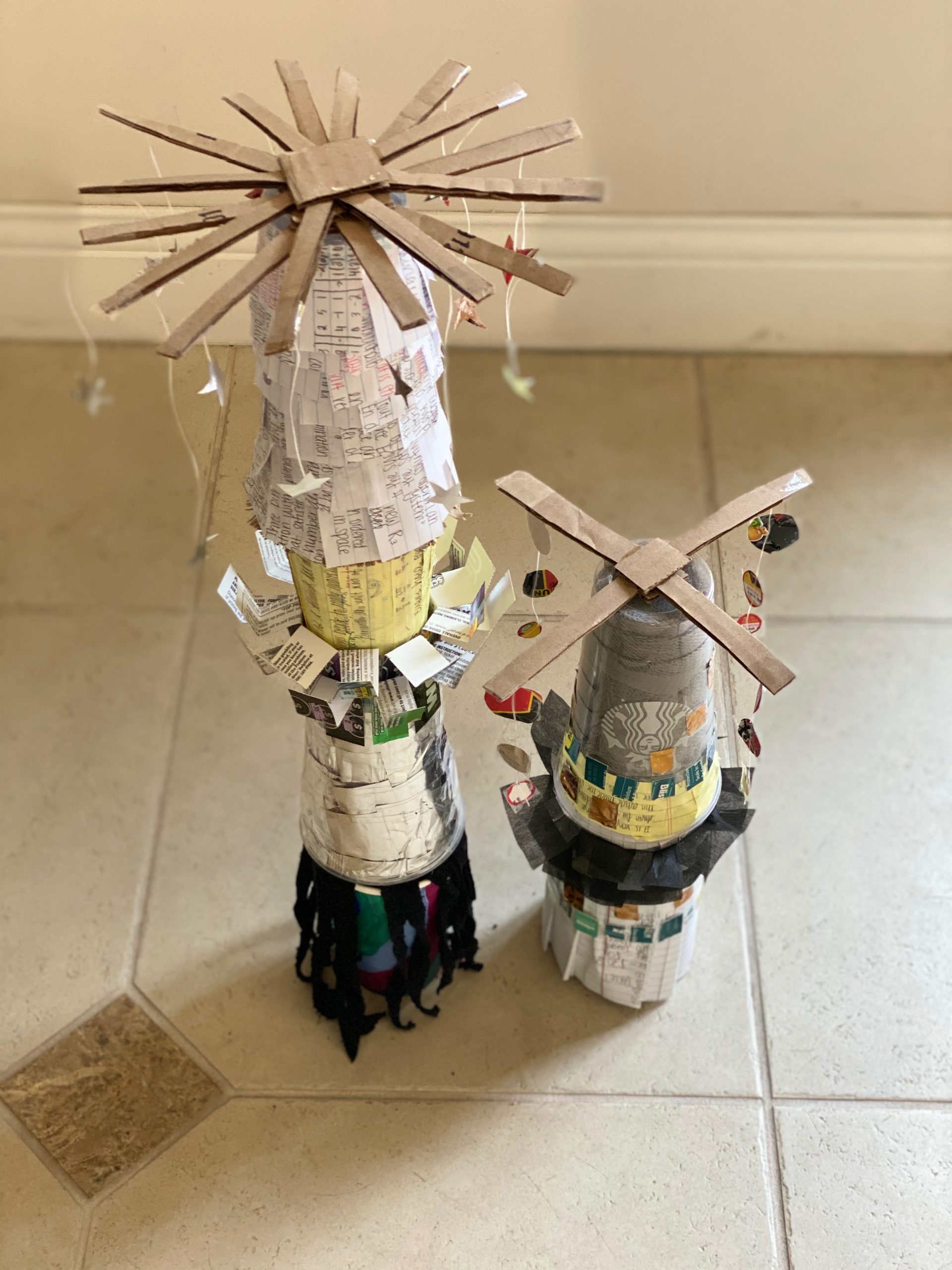
This piece is a heavily distorted video. The screen begins a bright magenta before seemingly “breaking apart” into a fragmented image. Bright, saturated colors, alongside dark blacks and bright whites fill the screen. The original video’s text and image are divided into rectangular sections that shift around the screen, moving in large bands – rendering them nearly unintelligible to the eye. Then, these rows of color are given a background of a colorful, tinted checker pattern, which also moves from side to side. These distorted masses of color move around the screen, changing with every scene from the original video. This, however, is interrupted at the end of the video. The screen shifts from the bright, colorful flashes to the original video, suddenly. In black and white, a man stands, in front of his face is text reading “‘The Mummy’ Re-released by Realart Pictures, Inc.” – stark in contrast to the previous two minutes of databent footage. After this glimpse of the original, the screen turns to a solid black and the video ends.
This work was created while this class discussed the process of databending. What caught my attention in learning about data bending was the opportunity for the relinquishment of an artist’s control. The process of databending, especially for artists with minimal prior experience, can rely much on the machine’s innate processes and less so on an intended outcome preconceived in the artist’s mind. I thought that this contrasted much with movie and film production, a format of video art that heavily relies on the work of the artist and their respective mastery of the medium. I thought that using an old Hollywood film, (in this case) The Mummy, would provide a sense of contrast in this work. I wanted to take a type of work known for its control and attention to detail and to reformat it through a process that I felt I had minimal direct, artistic, control over.
This process involves manipulating a video’s file format so that the video file could be opened with an audio-editing program. For this work, I put the original The Mummy (1932) trailer into the audio editing program Audible and selected different sections of the trailer to transform with audio effects. I imported and exported the audio file from the program many times, testing the effects that I applied, ensuring that I hadn’t completely broken the file. In this work, I utilized the Wah-Wah effect as well as the treble and bass editors to create the final product, interspersing which sections I edited. After I transformed the audio file, I did a final export of the piece and converted it into an MP4 file that could play on my computer.
To me, databending is a very interesting process because of its balance of machine and artist control over the artwork. Especially to someone new to the medium such as myself, the exact outcome of the edits I made to any certain file were unknown until they were completed. This process allowed for the work to, in a way, have a unique character that I could never have achieved through merely editing a file on video-editing software.

This piece is a short video of the natural world. Images of birds, squirrels, and plants flash by rapidly, in quick succession. The footage moves around the image of the wildlife creatures, constantly re-centering on the animals’ eyes. The footage is somewhat pixelated – fragmented through the camera distortion of a computer screen. Some sections of the video are of clearer quality than others. The video has no narrative progression, ending with the same footage of a bird that began the video.
I created this work in tandem with learning about rescanned video art. I felt motivated by the contrast between the natural world and the layers of digital processing present in the creation of rescans. I hoped that putting these two different elements together would provide an interesting place for this work to come from. I was interested in trying to focus on the eyes of different animals in order to have an element for the audience to follow and to be drawn back in with. Despite the usage of numerous different video sources, having a central “eye” element would allow for more cohesion in my rescan video.
For this work, I rescanned multiple different videos from Youtube. I took these rescans and uploaded them to a video editing program – from there I trimmed and re-arranged the video footage. Originally, I placed the videos in a random order, to try and differentiate the rescan’s order of images from the original state of the video on Youtube. From there I rearranged a few of the clips to have a better flow between different birds and creatures. After this, I experienced technical difficulties – losing access to the footage I had created. From here, I restarted the process I had undertaken at the beginning of the project. I attempted to order the clips in the same arrangement from the now lost videos. Restarting this process again allowed me another chance to consider the order of the clips used in the video, and, ultimately, gave me a fresh set of eyes to review my work.
Personal meaning of the piece.
I think that the distortion of my rescan work reflects an “other” point of view and allows whoever views it to have a different perspective on the original material. The source of the rescanned videos used in this work is multiple different Youtube accounts dedicated to posting (what are aptly titled) videos for cats. These sorts of videos are long (often many hours) streams of the outdoors. A pile of birdseed is left on a table with a camera, and the creatures that approach the food source are captured on camera. To me, these videos remind me of time spent with my cats. I have three cats at home, and one of them is always enraptured by hours upon hours of home-made bird watching videos. This video, in a way, attempts to emulate how my cat might see these videos – focusing on small details, the rapid movements, and the overall pacing of the world.

This piece is centered around a scan of myself writing. The layer closest to the surface is fingerprints and dark red and blue drops of ink. Behind this are layers of unclear handwriting, translucent black marker written over itself. Behind this is a layer of hands – on the left, fingers press hard onto the scanner, on the right a dark mass of hand presses sideways onto the screen. Across this back layer is a zig-zagging, dark and translucent distorted shape. The layer behind this is an off-green tone, the ambient lighting of the room in which the scan was taken.
This work was created for a connected series, in which each scan would be connected to an element from the previous work in the scan. For my series, I moved from the process of putting ink into a tray, to moving the tray on the scanner, to focusing on my hands, to capturing my hands writing text. This image is the final piece of the series – the process of writing. In this piece, I tried to combine the depiction of a process from the earlier ink drop pieces, with the focus on movement in the middle works, with images of my hands (which had been scattered throughout the series), with text, so that this image would represent a culmination of the rest of the series.
In making this work, I laid down layers of plastic on top of the scanner – cling wrap covered in ink spots, clear plastic covered in inked fingerprints, and a clear sheet covered in writing. Many of these specific elements were created in the process of making the earlier scans of the overall series, adding a sense of cohesion. I took multiple scans of myself writing in loose cursive, trying to keep up with the speed of the scanner. After capturing numerous scans of myself writing, I edited them together in a photo-editing program, allowing for multiple layers to combine. I tried to align the images so that the written text would not be directly layered on top of itself, but misaligned enough that the text would appear to be multiplied and distorted.
With this work, I tried to capture the movement and the chaos of writing. By unifying multiple scans of the same action, over and over again, I tried to make a work that would depict the action of a process – a theme throughout my series. Additionally, for this specific piece, I wanted to contrast the purpose of writing – expressing a meaning with text that is not legible and indecipherable. By layering numerous scans, moving my hands over top of the scanner, and slightly misaligning the writing, I hoped to de-emphasize the exact meaning of the words I was writing. This shift in attention, I hoped, would emphasize the action and the process that this piece is about.

The image is a scan of my face from three different angles – the right, front-facing, and the left. There is a strong contrast between the areas closest to the surface, which are illuminated by the scanner’s internal light, and the receding areas, dark in shadow. The darkness of the backing areas is segmented by the scanner’s distortion, creating a vertical ripple across the central face. The precision of the scanner picks up on details of my face that are not readily visible to the eye – pores, scarring, freckles, and moles. The plane closest to the surface, more forward than the rest of my face, is covered in a layer of dust, which has also been illuminated by the scanner’s light.
This piece was created for an assignment on portraiture. For this piece, I wanted to both capture my own face with the scanner, but also emphasize the scanner’s ability to distort. The contrast between the clarity of the illuminated frontal areas and the shaded, unclear backing areas was what I hoped to achieve in this work.
To make this piece, I moved the scanner around my face, while sitting underneath a dark sweater to block out the overhead lighting of the room that I was in. I scanned the right half of my face first, to allow the scanner to capture a more stable, less distorted image first, but as I moved the scanner across the rest of my face, I had less control over its exact stability, leading to the distortion in the center of the piece. Once the scanner reached the other side of my head, I tried to re-stabilize the image at the other end, creating a sort of conclusion to the piece. After scanning my head, I edited the scan – increasing the contrast of the image.
With this work, I wanted to create an image with multiples of myself, rather than one cohesive, stable scan of my face. Having three, incomplete and (to varying degrees) distorted images, as opposed to a typical portrait’s one, complete image of a person, allows for this work to express a fragmented and incomplete sense of self. Additionally, when I created this work, my eyes staring down at the scanner were transformed into three different views of myself looking out towards a fourth self (myself, or anyone else who views this work). The dark background and strong contrast make this work have an air of secrecy to it, as though the viewer and the three angels of my face are speaking about something private. Not only is the sense of identity in this portrait fragmented and incomplete, it is also private, being shared between whoever views it, and (these different versions of) myself.

The work is a long image, covered in layers of distorted text. The text itself is multiple fonts and colors – the background lettering is white, outlined in black, while the front-most text is black with occasional, small sections of red. The center of the image is orange and yellow, an image of fire. Both the text and this central image repeat throughout the entire image, overlapping themselves.
I created this piece in response to the text written on the object I scanned to create this work. By moving the card down the scanner while it was processing the image, the work looks less like a static image of Hell, and more like a movement towards it. The elongated flames and the spiraling, growing text creates, in my eyes, a sense of falling, mirroring the kind of damnation that the card references.
To make this work, I used two different scans of the same item. I scanned the front side first, dragging it down the scanner, moving it from side to side as well, to distort it. I repeated the same process for the other side of the item, following a similar process of slightly moving it while it was dragged down the scanner. After getting these two scans, I laid them in an image editor, adjusting the opacity and layering so that both sets of text were visible.
I created this piece with a handout that I got at a store, back home in Ohio a year or so ago. The front of the card has the foreboding title “Who Will Jesus Eternally Punish in Hell?” with a list beneath of types of people (To name a few: “Homosexuals,” “Abortionists/Murderers,” “Sorcerers,” and the “Unbelieving.”) next to cited bible quotes, underneath this text on the card is an image of Hell – dark clouds, fire, and towering, ominous figures. This is the bottom layer of my image. The top layer is from the other side of the card, reminding those types of people listed on the front of the card that they “still have hope” and can find redemption in Jesus. To me, the original card’s text is rather zealous and offensive, which contrasts greatly with the mundanity in which I obtained it (a grocery store). To me, this work is my own expression of life in Ohio.

